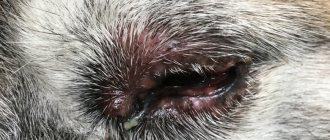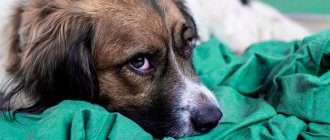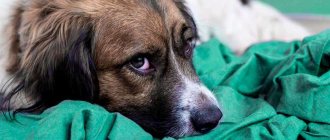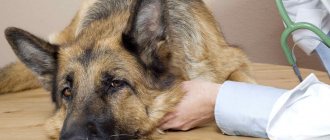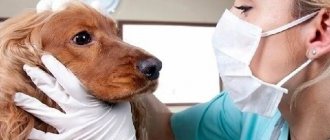Health problems in dogs often affect their eyes. Swollen, inflamed eyelids in most cases indicate ophthalmological problems. But sometimes swelling is a symptom of a number of internal diseases. From our article you will learn the possible reasons why a dog has a swollen eye, and what the owner can do to help his pet.
The main forms of blepharitis in animals
Blepharitis in cats and dogs occurs in different forms. Not only the symptoms of the disease, but also the treatment of the animal depend on this. The veterinarians of the Berloga clinic have prepared a brief overview of the different forms of blepharitis - this will allow you to detect the disease in a timely manner and seek veterinary help from professionals in order to avoid serious consequences for the health of your pet:
| Form of blepharitis | Review |
| Scaly (simple) blepharitis | Most often occurs in a chronic form. At the initial stage, there is redness of the edge of the eyelid, as well as the adjacent conjunctiva - the mucous membrane of the eye that covers the outside of the eyeball. Exudate collects in the corner of the eye. Please note that due to the itching that occurs with scaly blepharitis, cats and dogs constantly scratch their eyes - this often leads to injuries to the organs of vision. If you consult a veterinarian in a timely manner, the prognosis is favorable, otherwise the consequences of scaly blepharitis often include inversion or eversion of the eyelids, as well as deterioration of vision. |
| Ulcerative blepharitis | More often it occurs in an acute form, and the causes of its occurrence are usually purulent infections. A characteristic sign of ulcerative blepharitis in dogs and cats is swelling of the edge of the eyelid and the formation of pustules - pustules. After the purulent contents are removed, ulcers remain. The consequences of ulcerative blepharitis include bleeding of the eyes and eversion of the eyelids. In severe cases, the entire edge of the animal's eyelid is covered with pustules. |
| Phlegmonous blepharitis | Usually occurs in a one-sided form. The lesion covers the tissues of the eyelids; in severe cases, it additionally spreads to other areas - forehead, nose. Please note that due to its large size, the tumor often protrudes outward. Signs that distinguish phlegmonous blepharitis are the discharge of pus and mucus from the animal’s organs of vision. An increased body temperature may occur. 5-7 days after the onset of the disease, the abscess opens on its own. One of the consequences of phlegmonous blepharitis, which is possible if you do not go to a veterinary clinic in Moscow in a timely manner, is deformation of the animal’s eyelid due to the formation of granulation - young connective tissue. |
Additionally, blepharitis in dogs and cats is divided into several types. According to the place of origin, it can be anterior marginal - affects the skin of the eyelid and the ciliary zone, posterior marginal - the meiombian glands and surrounding tissues, angular - the corners of the eyes, and mixed .
Necessary prevention
To keep your pet from getting sick, proper care is necessary. First of all, this is proper feeding of the dog. If the bulldog eats ready-made food, then purchase premium or super-premium varieties. They contain all the additives necessary for normal life.
When a dog changes teeth, it is recommended to add potassium and phosphorus to its food.
If your pet is breastfed, it is necessary to add vitamin complexes to the food.
Vitamins are contained in the following products:
- Vitamin A is responsible for proper metabolic processes and is found in apples and liver.
- The action of vitamins from group B is similar to the action of vitamin A; they are found in fermented milk products, liver and yeast.
- Vitamin C helps the absorption of calcium and organizes the work of connective tissue. There is a lot of it in tomatoes and liver.
- Vitamin D promotes the absorption of potassium and phosphorus and is found in vegetable oils, dairy products, cheese, cottage cheese, etc.
- Vitamin E is necessary for the production of red blood cells and improves skin condition. It is found in meat, buckwheat, and liver.
- Vitamin H is involved in lipid-carbohydrate metabolism and helps improve the condition of the hair. Contained in liver, kidneys, yeast.
- Vitamin K is necessary for the health of the nervous system and for maintaining phosphorus in the body. Contained in seafood, cabbage, yolks.
All major diseases of the French Bulldog can be prevented or, in any case, detected at the very beginning of their development.
As is the case with other breeds, preventive measures come down to following the basic rules of a healthy lifestyle:
- Undergoing routine vaccination against hepatitis, enteritis, plague, rabies and other dangerous diseases.
- The use of vitamin and mineral supplements, for example, “8 In 1 Excel Deter”, “Beaphar Laveta Super”, “WOLMAR WINSOME PRO BIO PRO HAIR” and others.
In the case of French bulldogs, fish oil, vitamin D to maintain bone strength, as well as vitamins E and H, which protect the skin and coat and strengthen the reproductive system, are especially important.
Thus, when purchasing a French bulldog puppy, you should immediately become thoroughly familiar with the diseases that this breed especially often suffers from. If you take timely preventative measures, the risk of developing the disease is significantly reduced.
Routine vaccination
To reduce the risk of most dangerous diseases in French bulldogs, they must be vaccinated on time. Timely vaccinations can protect your dog from diseases such as canine distemper (distemper), rabies, parainfluenza, trichophytosis, leptospirosis, hepatitis, and paraviral enteritis.
In order for vaccinations to help your pet, they must be carried out according to the following schedule:
- first vaccination – dog age: eight to nine weeks;
- second vaccination – dog age: twelve to thirteen weeks;
- third vaccination – dog age: thirty to thirty-first week;
- Rabies vaccination – dog age: no earlier than twelve months.
After the first three vaccinations, they must be repeated every year at the same time. All vaccinations must be done using the same drug, for example, Nobivak. Before each vaccination, the French Bulldog must be dewormed (deworming) two weeks before. For this purpose, you can use the drug "Drontal".
Before each vaccination, you need to check the physical condition of your pet - he must be absolutely healthy. Also, pregnant and lactating French Bulldog bitches should not be vaccinated.
Rabies vaccination should also be done every year, for example, using the drug Nobivak DHPPI RL.
Causes of blepharitis in dogs and cats
Blepharitis in animals is caused by various causes - infectious and non-infectious. The main factors that provoke inflammation of the eyelids include:
- eye damage – active scratching, bruise or other injuries;
- burns;
- endocrine disorders – hypercortisolism syndrome, hypothyroidism;
- bacteria – staphylococci, streptococci;
- parasites: in dogs – causative agents of demodicosis and sarcoptic mange, in cats – notohedrosis;
- autoimmune diseases;
- fungi;
- allergic reactions – to food, medications, care products;
- seborrhea.
Additionally, the course of blepharitis in animals is influenced by external factors - dust, smoke, wind. By themselves, they usually do not cause inflammation of the eyelids, but they can worsen the course of the disease and intensify the clinical picture - symptoms.
Stye on the eye
Styes in animals appear due to mechanical damage to the eyelid. This disease is bacterial in nature and is very recognizable, as it is a large subcutaneous pimple on the eyelid. The disease develops due to blockage of the sebaceous gland ducts, followed by infection.
Treatment consists of antiseptic treatment of the eyelid and the use of antibacterial agents. In this case, eye ointments with an antibiotic (Tetracycline ointment, Levomecitin) are effective; therapy can be supplemented with Albucid drops, but they cause a strong burning sensation, so it is difficult to apply eye drops to your pet.
Allergic swelling in the eyes successfully disappears a few hours after the irritant stops and antihistamines are taken. If the disease is bacterial in nature, a short course of treatment is necessary. As a rule, the duration of therapy does not exceed 4-5 days.
Signs of blepharitis: a reminder for the owner
Symptoms of blepharitis in dogs and cats depend on its form, including scaly, ulcerative and phlegmonous. However, it is possible to identify general signs - those that are characteristic of all or several forms of the disease at once.
Common symptoms of blepharitis in dogs and cats:
- redness of the edges of the eyelids,
- hyperemia,
- thickening of the eyelids,
- itching,
- decreased visual function,
- temperature increase,
- formation of ulcers,
- sticking or loss of eyelashes,
- accumulation of exudate,
- formation of scales along the eyelash line,
- baldness of the eyelid edges,
- lacrimation,
- painful sensitivity of the eyes to light - photophobia,
- apathy.
Attention! Due to itching and constant discharge, animals scratch their eyes with their paws and rub against various objects, which is why injuries to the organs of vision are often observed.
If you notice one or more signs in your pet that indicate the development of blepharitis, then do not hesitate - make an appointment with a veterinarian in Moscow. The specialist will quickly diagnose and do everything necessary to restore the animal’s health!
Vaccination: the importance of the procedure
Timely vaccinations will protect the “French” from diseases. Especially from diseases such as:
- distemper (canine plague);
- rabies;
- parainfluenza;
- trichophytosis;
- leptospirosis;
- hepatitis;
- parvovirus enteritis.
There is a specific vaccination schedule:
- At the age of 8–10 weeks, the first vaccination is given.
- 12-13 weeks - the second vaccination is given.
- At the age of 30-31 weeks - the third vaccination.
- A dog is vaccinated against rabies no earlier than one year of age.
The first three vaccines are repeated exactly one year later. It is desirable that the times coincide. The administration drug should also be the same. Experts advise deworming your French bulldog two weeks before vaccinations.
Diagnosis of the disease
The first thing that is necessary is to perform diagnostics. The veterinarian examines the pet, conducts an examination of the fundus - ophthalmoscopy, and, if necessary (for example, if infectious diseases are suspected), prescribes additional laboratory tests.
All this is necessary in order to differentiate blepharitis from demodicosis, as well as determine its form and cause of occurrence. This will determine the program that will be used to treat your pet's blepharitis.
Attention! Diagnosis will not take much time - an experienced veterinarian will quickly examine the cat or dog, make an accurate diagnosis and determine the extent of damage to the eyelids.
Contact your veterinarian
You cannot ignore the problem or desperately try to fix something that is no longer within your power to fix, when medical, professional intervention is necessary.
- Bite of a poisonous animal. A snake bite, or even an insect bite, may require disinfection of the affected area and the administration of a special drug.
- Suppuration. In case of severe suppuration, the help of a veterinarian is necessary.
- Strong pain. If your puppy is rolling on the floor in pain or squealing, consult a doctor to relieve your pet's pain.
- Severe allergies. When the face began to swell, it was no longer possible to cope with it on my own. In this situation, you need to go to the clinic as soon as possible to avoid blocking the airways.
How to treat blepharitis in dogs and cats?
To effectively treat blepharitis in animals, an integrated approach is used. It involves the use of antimicrobial, steroidal and non-steroidal anti-inflammatory drugs, as well as desensitizing agents - they reduce the increased sensitivity of dogs and cats to various allergens.
Treatment of blepharitis in animals, on the one hand, is aimed at eliminating the cause that provoked the onset of the disease, and on the other, at eliminating the symptoms. Additionally, drops are prescribed for blepharitis in cats and dogs. They soften and restore eye tissue, eliminate discomfort and itching, promote rapid healing of damage, and have an antimicrobial effect.
Recommendations for caring for animals with blepharitis
The first and most important thing is to seek veterinary help in a timely manner. Do not try to treat blepharitis in a cat or dog at home - in some cases, self-medication of the animal can lead to serious and irreversible consequences, including sepsis (blood poisoning), complete loss of vision and death.
Basic recommendations for caring for dogs and cats diagnosed with blepharitis:
- Follow all the veterinarian's recommendations, including regarding the medications to be used, as well as the dose and method of their use - the health of your pet depends on this;
- Provide your dog or cat with a place to rest - make sure there is a bed, no drafts or extraneous noise, place a bowl of water and food nearby;
- Nutrition during the treatment of blepharitis should be as balanced as possible - this is important for the restoration of the animal’s body; the veterinarian will give recommendations on nutrition individually.
Folk remedies
For bacterial conjunctivitis, it is permissible to be treated using traditional medicine .
Important! But such a course, which should be carried out in parallel with the main course, must be agreed with the attending physician, since patients may have contraindications to some components and ingredients.
In addition, some products may be incompatible with medications prescribed by an ophthalmologist.
Here are some common and safe prescriptions :
- Several small dried aloe leaves are crushed and poured with boiling water in the ratio of “1 teaspoon of plant to two glasses of boiling water.” After the solution has cooled, you can use it to make compresses or wash your eyes . If there are no allergic reactions to aloe, freshly squeezed aloe juice . But in this case, it must be diluted with boiled water in a ratio of 1:10, and if the symptoms of the disease intensify or in case of irritation of the organs of vision treated with this product, its use is canceled.
- One hundred grams of dried and crushed marshmallow roots are poured into a glass of cold boiled water and left for six hours. After this time, the infusion is filtered, and the finished product can be washed with the eyes two to three times a day.
- A teaspoon of dried and crushed rose petals is poured into a glass of boiling water and left for half an hour. The solution is also used for rinsing.
Treatment with folk remedies should not replace drug therapy: such methods are only suitable for relieving the symptoms of conjunctivitis in complex treatment.

